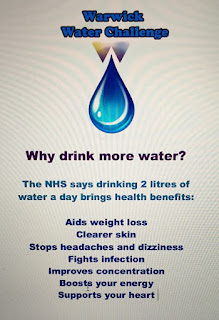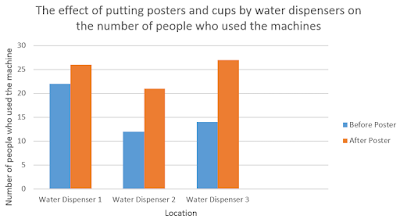So how do you do this? Read on…
Promoting Positive Self-Esteem
The aim of this project was to promote positive self-esteem in female students at The University of Warwick.Research has shown that there is a correlation between self-esteem and make-up usage (Scott, 2007), specifically, the higher the make-up usage, the lower the self-esteem. We as females use make-up for different reasons and at different times. For some females, they may not feel as confident without make-up. For other females, they only use make-up when they go out. Therefore, we reasoned that increasing self-esteem will result in an increase in feelings of positivity about their facial features and result in a decrease in make-up use.We asked females to indicate how they felt statements relating to self-esteem relate to them. Following this, we asked them to list 6 facial features they like and 12 facial features they dislike. This was our availability heuristic (Schwarz, Bless, Strack, Klumpp, Rittenauer,-Schatka & Simons, 1991). The point of this was increase the salience of facial features they liked and decrease the salience of features they dislike. This should hopefully result in an increase in feelings of positive self-esteem. After this, we asked if these females were willing to go seven days without wearing make-up. Some said yes. Some said no.For those who said yes, we took a pre-test measure of how many days a week they use make-up and a post-test measure of how many days a week they use make-up. The results revealed there was a slight decrease in the amount of make-up used following the implementation of the availability heuristic (Figure 1). Since self-esteem and make-up use have been found to be correlated, this finding was interpreted as evidence that self-esteem had increased. Therefore, we had increased their self-esteem by promoting positive feelings about their facial features. Figure 1 shows the number of days participants applied make-up in the week before and after the availability heuristic was applied.The media we chose for our project was Instagram. We created a page called ‘Project Makedown’. We asked females to write down one feature which they like about themselves without make-up and asked if we could take a picture to use for our Instagram page. Below are some examples. The hope is to increase our number of followers and make our desired change viral. You can visit our page here:https://www.instagram.com/projectmakedown/?hl=en
Figure 1 shows the number of days participants applied make-up in the week before and after the availability heuristic was applied.The media we chose for our project was Instagram. We created a page called ‘Project Makedown’. We asked females to write down one feature which they like about themselves without make-up and asked if we could take a picture to use for our Instagram page. Below are some examples. The hope is to increase our number of followers and make our desired change viral. You can visit our page here:https://www.instagram.com/projectmakedown/?hl=enFehinti Adesiyan & Gloria WilliamsReferencesSchwarz, N., Bless, H., Strack, F., Klumpp, G., Rittenauer-Schatka, H., & Simons, A. (1991). Ease of retrieval as information: Another look at the availability heuristic. Journal of Personality and Social psychology, 61(2), 195.Scott, S. (2007). Influence of cosmetics on the confidence of college women: an exploratory study. Unpublished doctoral dissertation). Hanover College, IN. Retrieved from http://psych. hanover. edu/research/thesis07/scottpaper. pdf.
Encouraging people to drink more water
Most people already know that drinking water is good for us. But how many of us actually drink the recommended 2 litres a day? We believe that it is important to promote the benefits surrounding consuming enough water to students at the University of Warwick. As exams draw closer and deadlines loom, the cognitive and performance based benefits that water can offer are more important than ever.There is a wealth of research which demonstrates the importance of drinking enough water. For example, drinking water before a test improved people’s scores as well as their mood (Edmonds & Jeffes, 2009). Drinking sufficient water also means that the body can operate efficiently and optimally, which is vital during the stress of exams and deadlines.Our project was aimed at making the benefits of drinking water salient in order to encourage students to drink more. In order to do this, we placed posters above and next to various water dispenser machines in high-traffic areas around the university campus. We used big, bold fonts and bright colours on the posters to catch the eyes of passers-by, and bring their attention to the free water they could get from the dispensers. We also made badges with a distinctive water-drop logo on, as used in the posters, and offered these to people who had used the machines. This used the behavioural influence technique of salience (Chaiken & Eagly, 1983), which means that the behaviour of drinking water was brought to their attention. 


We also placed cups next to the dispensers so people could quickly and easily get a drink of water. This was based on the opportunity part of the framework of behavioural influences by Fishbein et al. (2001). This means that a behaviour can only occur if the individual has sufficient opportunity to complete it. By providing cups we were making sure that every passer-by had the opportunity to drink water, not just those who already had a water bottle to fill up. The posters we displayed also contained the health benefits of drinking water. This was based on the central route processing of the Elaboration Likelihood Model (Petty & Cacioppo, 1986). We believed that this would be an appropriate way of persuading students as they are an educated audience who will therefore be more influenced by a strong factual message. To measure if our intervention led to behaviour change we compared the amount of people using the water dispensers before the posters and cups and afterwards. We took a baseline tally score for each water dispenser over an hour period. We used an hour long period so that there would be movement between lectures. We then put the posters up and supplied the cups and did a second tally score of how many people used the dispenser. The baseline test and intervention test was both completed on the same day. We found that there was an increase in the number of people using the machines after we put up the posters and put the cups next to the machines, suggesting these helped people to change their behaviour and drink more water from the dispenser machines. This suggests that by making a behaviour salient and providing adequate opportunity for people to complete the behaviour, people are more likely to drink more water. This technique could be used to encourage other forms of positive behaviour around campus such as putting your litter in the bin and turning off lights. The graph shows the number of people who used each water dispenser before and after the posters and cups were put by the machines.
 Preeya ChibbraSandev PanaserBecky SeversReferences: Chaiken, S., & Eagly, A. H. (1983). Communication modality as a determinant of persuasion: The role of communicator salience. Journal of personality and social psychology, 45(2),241. Edmonds, C. J., & Jeffes, B. (2009). Does having a drink help you think? 6–7-Year-old children show improvements in cognitive performance from baseline to test after having a drink of water. Appetite, 53(3), 469-472. Fishbein, M., Triandis, H. C., Kanfer, F. H., Becker, M., & Middlestadt, S. E. (2001). Factors influencing behavior and behavior change. Petty, R. E., & Cacioppo, J. T. (1986). The elaboration likelihood model of persuasion (pp. 1-24). Springer New York.
Preeya ChibbraSandev PanaserBecky SeversReferences: Chaiken, S., & Eagly, A. H. (1983). Communication modality as a determinant of persuasion: The role of communicator salience. Journal of personality and social psychology, 45(2),241. Edmonds, C. J., & Jeffes, B. (2009). Does having a drink help you think? 6–7-Year-old children show improvements in cognitive performance from baseline to test after having a drink of water. Appetite, 53(3), 469-472. Fishbein, M., Triandis, H. C., Kanfer, F. H., Becker, M., & Middlestadt, S. E. (2001). Factors influencing behavior and behavior change. Petty, R. E., & Cacioppo, J. T. (1986). The elaboration likelihood model of persuasion (pp. 1-24). Springer New York.
- « Previous Page
- 1
- …
- 10
- 11
- 12
- 13
- 14
- …
- 88
- Next Page »